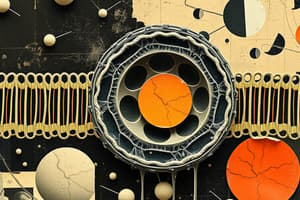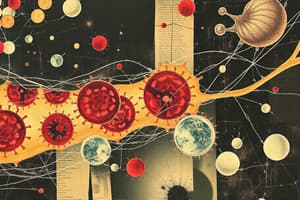Podcast
Questions and Answers
What is the main purpose of single particle tracking in the study of membrane dynamics?
What is the main purpose of single particle tracking in the study of membrane dynamics?
- To follow the movement of lipid molecules over a long time scale
- To track the movement of a single lipid molecule on a shorter time scale (correct)
- To visualize all lipid molecules simultaneously
- To analyze the composition of lipid bilayers
What characteristic of integrins makes them essential for cell adhesion?
What characteristic of integrins makes them essential for cell adhesion?
- They are soluble proteins that do not interact with membranes
- They contain multiple identical subunits that facilitate adhesion
- They solely provide structural support without signaling
- They are anchored to the plasma membrane by hydrophobic transmembrane helices (correct)
Which type of interaction do cadherins typically engage in to mediate adhesion between cells?
Which type of interaction do cadherins typically engage in to mediate adhesion between cells?
- Homophilic interactions with identical cadherins (correct)
- Hydrophilic interactions with extracellular matrix proteins
- Heterophilic interactions with integrins
- Non-specific interactions with any membrane protein
What is a key function of integral membrane proteins beyond cell adhesion?
What is a key function of integral membrane proteins beyond cell adhesion?
What type of transport occurs when solutes move against their concentration gradient?
What type of transport occurs when solutes move against their concentration gradient?
How might ions cross the plasma membrane according to the provided information?
How might ions cross the plasma membrane according to the provided information?
What role do selectins play in cell interactions?
What role do selectins play in cell interactions?
What drives the transport of solutes against a concentration gradient?
What drives the transport of solutes against a concentration gradient?
What do the labels S0, S1, and S2 in a Jablonski diagram represent?
What do the labels S0, S1, and S2 in a Jablonski diagram represent?
What is typically observed regarding the energy of emission compared to absorption?
What is typically observed regarding the energy of emission compared to absorption?
What is one common cause of the Stokes shift?
What is one common cause of the Stokes shift?
Which of the following statements about fluorescence spectroscopy instrumentation is false?
Which of the following statements about fluorescence spectroscopy instrumentation is false?
The phenomenon of fluorescence typically results in which of the following?
The phenomenon of fluorescence typically results in which of the following?
What significant observation was made by Sir G.G. Stokes related to fluorescence?
What significant observation was made by Sir G.G. Stokes related to fluorescence?
Which process occurs after a fluorophore absorbs light?
Which process occurs after a fluorophore absorbs light?
Which factor does NOT contribute to the Stokes shift?
Which factor does NOT contribute to the Stokes shift?
What primarily contributes to the flexibility of biological membranes?
What primarily contributes to the flexibility of biological membranes?
At low temperatures, how do lipids in a bilayer behave?
At low temperatures, how do lipids in a bilayer behave?
What is the status of trans-bilayer diffusion of lipids at physiological temperature?
What is the status of trans-bilayer diffusion of lipids at physiological temperature?
What happens during lateral diffusion of lipids in the membrane?
What happens during lateral diffusion of lipids in the membrane?
What is the main reason that trans-bilayer movement of lipids requires catalysis?
What is the main reason that trans-bilayer movement of lipids requires catalysis?
What technique is commonly used to measure the lateral diffusion of lipids?
What technique is commonly used to measure the lateral diffusion of lipids?
What occurs at intermediate temperatures in lipid bilayers?
What occurs at intermediate temperatures in lipid bilayers?
Why is it that lipid molecules in bilayers are not covalently anchored?
Why is it that lipid molecules in bilayers are not covalently anchored?
What is the primary mechanism by which solutes move from an area of higher concentration to an area of lower concentration across a membrane?
What is the primary mechanism by which solutes move from an area of higher concentration to an area of lower concentration across a membrane?
What term is used to describe the combined effect of transmembrane electrical gradients and concentration gradients on ion movement?
What term is used to describe the combined effect of transmembrane electrical gradients and concentration gradients on ion movement?
Which type of transporters bind substrates with high specificity but operate at lower transport rates?
Which type of transporters bind substrates with high specificity but operate at lower transport rates?
What is the role of ion-selective channels in the plasma membrane?
What is the role of ion-selective channels in the plasma membrane?
What is the result of rapid changes in ion channel activity in neurons?
What is the result of rapid changes in ion channel activity in neurons?
How do ion pumps, such as the Na+ K+ ATPase, contribute to the function of a plasma membrane?
How do ion pumps, such as the Na+ K+ ATPase, contribute to the function of a plasma membrane?
During muscle contraction, which ions are released as a result of channel opening in the sarcoplasmic reticulum?
During muscle contraction, which ions are released as a result of channel opening in the sarcoplasmic reticulum?
What principle do the processes of solute movement adhere to, as reflected in the content?
What principle do the processes of solute movement adhere to, as reflected in the content?
What defines the ability of a fluorophore to absorb and emit light?
What defines the ability of a fluorophore to absorb and emit light?
Which of these is NOT listed as a key property of fluorophores?
Which of these is NOT listed as a key property of fluorophores?
Which of the following is one of the applications of fluorophores?
Which of the following is one of the applications of fluorophores?
What is the usual unit for measuring wavelength in the context of fluorophores?
What is the usual unit for measuring wavelength in the context of fluorophores?
Which of the following fluorophores is stated as being popular for antibody labeling?
Which of the following fluorophores is stated as being popular for antibody labeling?
Derivatives of which of the following compounds are considered common fluorophores?
Derivatives of which of the following compounds are considered common fluorophores?
What characteristic improvement is noted in the most recent generations of fluorophores?
What characteristic improvement is noted in the most recent generations of fluorophores?
Which type of fluorophore is categorized under organic dyes?
Which type of fluorophore is categorized under organic dyes?
What is the primary phenomenon that FRET describes?
What is the primary phenomenon that FRET describes?
Which factor does NOT influence the rate of energy transfer in FRET?
Which factor does NOT influence the rate of energy transfer in FRET?
The Förster distance is defined as the distance at which RET is what percentage efficient?
The Förster distance is defined as the distance at which RET is what percentage efficient?
In FRET, what is the state of the donor molecule when energy transfer occurs?
In FRET, what is the state of the donor molecule when energy transfer occurs?
Which distance range typically indicates the Förster distance for FRET?
Which distance range typically indicates the Förster distance for FRET?
What effect does a protease have on FRET between two fluorophores?
What effect does a protease have on FRET between two fluorophores?
How does the orientation of donor and acceptor molecules impact FRET efficiency?
How does the orientation of donor and acceptor molecules impact FRET efficiency?
In what application is FRET commonly used?
In what application is FRET commonly used?
Flashcards
Trans-bilayer diffusion
Trans-bilayer diffusion
The movement of a lipid molecule from one leaflet of the bilayer to the other.
Membrane flexibility
Membrane flexibility
The ability of a membrane to change shape without losing its integrity and becoming leaky.
Gel phase
Gel phase
The state of a lipid bilayer at relatively low temperatures where lipids form a semi-solid gel-like structure.
Liquid-disordered state
Liquid-disordered state
Signup and view all the flashcards
Liquid-ordered state
Liquid-ordered state
Signup and view all the flashcards
Lateral diffusion
Lateral diffusion
Signup and view all the flashcards
Fluorescence Recovery After Photobleaching (FRAP)
Fluorescence Recovery After Photobleaching (FRAP)
Signup and view all the flashcards
Lipid fences
Lipid fences
Signup and view all the flashcards
Simple Diffusion
Simple Diffusion
Signup and view all the flashcards
Concentration Gradient
Concentration Gradient
Signup and view all the flashcards
Membrane Potential
Membrane Potential
Signup and view all the flashcards
Electrochemical Gradient
Electrochemical Gradient
Signup and view all the flashcards
Transporters
Transporters
Signup and view all the flashcards
Carriers
Carriers
Signup and view all the flashcards
Channels
Channels
Signup and view all the flashcards
Ion-Selective Channels
Ion-Selective Channels
Signup and view all the flashcards
Single Particle Tracking
Single Particle Tracking
Signup and view all the flashcards
Protein Aggregation
Protein Aggregation
Signup and view all the flashcards
Integral Membrane Proteins
Integral Membrane Proteins
Signup and view all the flashcards
Integrins
Integrins
Signup and view all the flashcards
Cadherins
Cadherins
Signup and view all the flashcards
Passive Transport
Passive Transport
Signup and view all the flashcards
Active Transport
Active Transport
Signup and view all the flashcards
Ionophores
Ionophores
Signup and view all the flashcards
Jablonski Diagram
Jablonski Diagram
Signup and view all the flashcards
Light Absorption
Light Absorption
Signup and view all the flashcards
Light Emission
Light Emission
Signup and view all the flashcards
Stokes Shift
Stokes Shift
Signup and view all the flashcards
Vibrational Relaxation
Vibrational Relaxation
Signup and view all the flashcards
Spectrofluorometer
Spectrofluorometer
Signup and view all the flashcards
Emission Spectrum
Emission Spectrum
Signup and view all the flashcards
Absorption Spectrum
Absorption Spectrum
Signup and view all the flashcards
What is a fluorophore?
What is a fluorophore?
Signup and view all the flashcards
What is Excitation Wavelength?
What is Excitation Wavelength?
Signup and view all the flashcards
What is Emission Wavelength?
What is Emission Wavelength?
Signup and view all the flashcards
What is Quantum Yield?
What is Quantum Yield?
Signup and view all the flashcards
What is Photostability?
What is Photostability?
Signup and view all the flashcards
What is pH sensitivity?
What is pH sensitivity?
Signup and view all the flashcards
What is Fluorescence Microscopy?
What is Fluorescence Microscopy?
Signup and view all the flashcards
What is Flow Cytometry?
What is Flow Cytometry?
Signup and view all the flashcards
FRET (Fluorescence Resonance Energy Transfer)
FRET (Fluorescence Resonance Energy Transfer)
Signup and view all the flashcards
Förster distance
Förster distance
Signup and view all the flashcards
FRET to show protein-protein interactions
FRET to show protein-protein interactions
Signup and view all the flashcards
Atomic Force Microscopy (AFM)
Atomic Force Microscopy (AFM)
Signup and view all the flashcards
AFM to visualize membrane proteins
AFM to visualize membrane proteins
Signup and view all the flashcards
Rate of energy transfer in FRET
Rate of energy transfer in FRET
Signup and view all the flashcards
Study Notes
Membrane Dynamics
- Biological membranes are flexible, changing shape without losing integrity.
- Noncovalent interactions between lipids in the bilayer allow this flexibility.
- Lipids are not covalently anchored to each other.
- Membrane dynamics involve various lipid motions.
- Lipid bilayer structure is stable, individual phospholipid and sterol molecules have freedom of motion.
Lipid States
- At low temperatures, lipids form a semisolid gel phase (paracrystalline).
- At high temperatures, lipids are in constant motion, forming a liquid-disordered (fluid) state.
- At intermediate temperatures, lipids exist in a liquid-ordered state, showing less thermal motion in acyl chains, but still allowing lateral movement.
Trans-bilayer Lipid Movement
- Trans-bilayer ("flip-flop") movement of lipids is slow at physiological temperatures, as polar or charged head groups must leave the aqueous environment and enter the hydrophobic interior.
- Trans-bilayer movement requires significant energy input.
Lateral Lipid Diffusion
- Lipids and proteins diffuse laterally in the membrane.
- Fluorescence recovery after photobleaching (FRAP) shows this lateral movement.
- Lipids move as if corralled by fences, occasionally jumping regions.
- Many membrane proteins are mobile.
- Single-particle tracking visually confirms this lateral movement.
Membrane Protein Aggregates
- Some membrane proteins aggregate to create patches on a cell surface.
- Protein molecules do not move relative to each other within the patches.
- Acetylcholine receptors form dense patches on neuron plasma membranes in synapses.
Integral Proteins and Cell Interactions
- Integral proteins mediate cell-cell interactions and adhesion.
- Integrins are heterodimeric and anchored to the plasma membrane by a hydrophobic transmembrane helix.
- Integrins are not just adhesives, but also act as signal transducers.
- Other families, like cadherins, undergo homophilic interactions with identical cadherins in adjacent cells.
- Immunoglobulin-like proteins and selectins are involved in cell-cell interactions.
Solute Transport Across Membranes
- Membrane proteins facilitating solute diffusion are called transporters or permeases.
- Transporters bind substrates with high stereospecificity and catalyze transport, occurring below free diffusion rates.
- Channels allow rapid transmembrane movement, nearly at the limit of unhindered diffusion.
Ion Selective Channels
- Ion-selective channels facilitate ion movement across membranes.
- Channels, along with ion pumps (e.g., Na+/K+ ATPase), regulate ion concentrations and membrane potential.
- Rapid channel activity changes cause membrane potential changes in neurons (e.g., action potentials).
- Ca²⁺ channel opening in myocytes triggers muscle contraction.
Fluorescence Resonance Energy Transfer (FRET)
- FRET is an electrodynamic phenomenon explaining energy transfer between molecules.
- FRET occurs between a donor (excited) molecule and an acceptor (ground) molecule.
- Donor emission wavelengths often overlap with acceptor absorption wavelengths.
- Energy transfer happens without photon appearance, through dipole-dipole interactions.
- The rate of energy transfer depends on spectral overlap, donor quantum yield, dipole orientation, and distance.
- FRET is used to analyze protein-protein interactions.
Atomic Force Microscopy (AFM)
- AFM is used for visualizing membrane proteins.
- A sharp cantilever tip is scanned over a surface.
- Electrostatic and van der Waals forces between tip and surface are measured.
- The technique can visualize features down to the nanometer scale.
Other topics
- Jablonski diagrams explain light absorption and emission processes.
- Fluorophores absorb and emit light in predictable ways and are used for various applications, like labeling compounds and visualizing cellular structures.
- The Stokes shift describes the difference between excitation and emission wavelengths in fluorescence.
- Spectrofluorometers measure fluorescence and absorption spectra.
Studying That Suits You
Use AI to generate personalized quizzes and flashcards to suit your learning preferences.
Related Documents
Description
Test your knowledge on key concepts related to membrane dynamics and cell adhesion. This quiz covers topics including single particle tracking, integrins, cadherins, and transport mechanisms across the plasma membrane. Assess your understanding of the roles different proteins play in cellular interactions.



